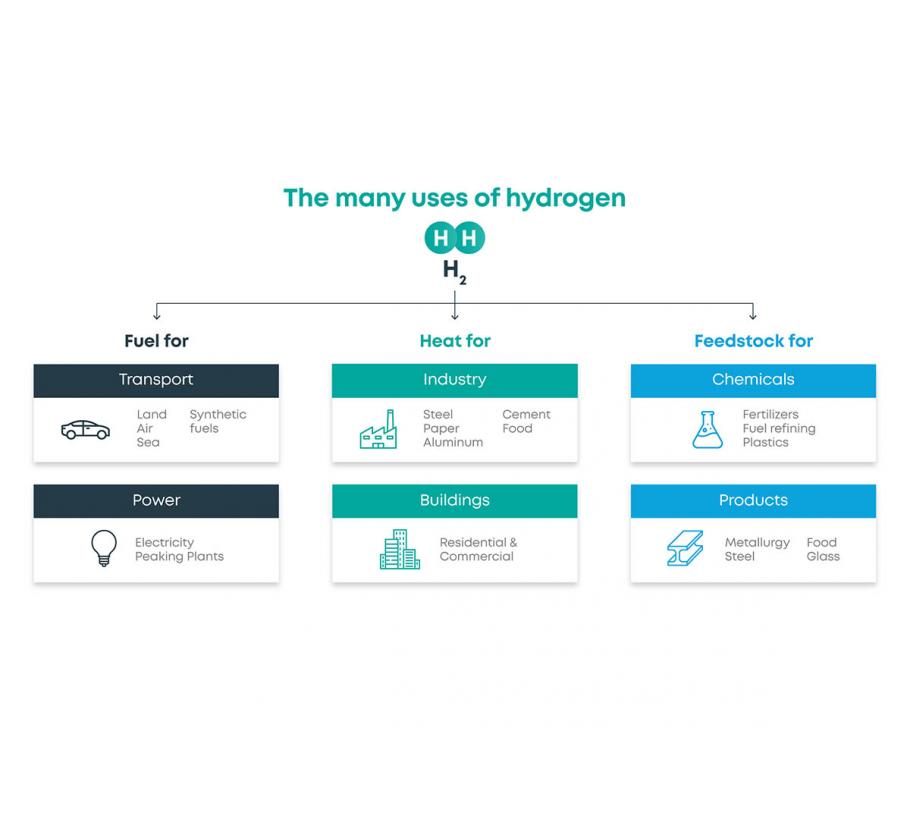Green hydrogen: zero emissions, infinite uses
HYDROGEN
Increasing hydrogen, decreasing costs
What can you do with 120 million tons of hydrogen(1)? Plenty! In fact, the number of new projects and technologies that use that annual global fuel supply is expanding rapidly.
While today’s hydrogen is produced from non-renewable processes and is almost exclusively used for industrial purposes, decarbonization efforts have made green hydrogen a viable alternative to fossil fuels.
Developing more low-cost applications will help the green hydrogen industry scale-up production, drive down costs across multiple sectors, and promote a more seamless energy transition.
Power Generation: Supporting the Intermittency of Renewables
For many years, hydrogen has been seen as a candidate for electricity generation and a provider of long-term renewable energy storage. Like natural gas, hydrogen can be stored in large quantities over long periods of time and used whenever power generation is required. The following applications are already taking shape in the power sector:
- Pipeline: In the near-term, hydrogen produced from renewables can be blended with natural gas and injected into gas pipelines. This is a low-cost steppingstone to reducing emissions from natural gas in buildings, industry, and power plants as 100-percent-hydrogen pipelines are developed.
- Turbines and Engines: For more than 20 years, more than 150 turbines have been burning fuels containing hydrogen globally. Nearly 50 have operated with a mix of more than 50 percent hydrogen, and it is now technically feasible for turbines to burn close to 100 percent hydrogen fuel.(2)
- Fuel Cells: Today, fuel cells power vehicles and generate electricity and heat on a small scale. They mostly run on hydrogen produced from natural gas, providing back-up power to network equipment (e.g., telecom towers) and datacenters, and supplying off-grid power in isolated regions. However, compared to a turbine’s electrical conversion efficiency rate of roughly 33 to 55 percent, fuel-cell power plants have a conversion rate of 45 to 60 percent—and, as a result, they also have a significant potential to expand.(3)

Transport: Fueling a Green Economy
While hydrogen can be used as a fuel in internal combustion engines, it is now almost exclusively used in fuel cells. These cells are lighter than electric car batteries, and offer longer driving ranges and shorter refueling times. Hydrogen fuel cell systems are suitable for nearly all means of transport, including aviation, industrial equipment, and the following sectors:
- Road Vehicles: Fuel cell electric vehicles (FCEV) are currently mass produced, and heavy-duty vehicles (buses, trucks) are coming to market within the next few years. According to the International Energy Agency, more than 380 hydrogen fueling stations are already open, and the Hydrogen Council expects 3,000 stations will be in operation by 2025, with the capacity to keep around 2 million FCEVs on the road.(4)
- Rail: Today, trains are either all-diesel or all-electric. While electrified railways reduce emissions, their energy is only about half as intense as diesel and requires a high capital expense to build overhead electric wires. Although hydrogen technology for rail is still in its infancy, the first fleet of hydrogen trains is already being launched commercially in northern Germany and another hydrogen-powered train in California is also under development.
- Shipping: The only near-term alternative to heavy fuel oil and diesel engines in the shipping sector is liquefied natural gas (LNG). However, hydrogen-powered fuel cells are being developed to propel smaller passenger ships and ferries, and liquefied hydrogen is being considered as an option to meet the International Maritime Organization's greenhouse gas emission reduction target of 50 percent by 2050.(5)
Industry: Transitioning to Green Hydrogen
Although hydrogen has been used throughout heavy industrial sectors for decades, most of the hydrogen in use today is produced from natural gas. As a result, a near-term opportunity exists to transition to hydrogen produced from renewables, reducing emissions in the following sectors:
- Chemicals: In the chemical sector, the largest industrial market for hydrogen, the primary chemical produced is ammonia (NH3), used as nitrogen fertilizer and for the production of other chemicals.
- Refining: Refineries are the second-largest industrial consumer of hydrogen. At oil refineries hydrogen is used for hydrocracking and for desulphurization of fuels.
- Liquid Fuels: Hydrogen is also an important basic substance for producing the liquid fuel methanol (CH3OH). Methanol is used directly as a fuel in internal combustion engines or in direct methane fuel cells.
- Other: Several other industrial sectors use hydrogen in their operations and have the potential to become massive end-users as technologies are scaled. These include iron and steel production, glass and ceramics manufacturing, and the cooling electrical generators. Currently, steelmaking uses coking coal as a carbon source. However, an alternative process called direct reduction via hydrogen is in demonstration phase, and has the potential to drastically decarbonize the steelmaking industry.
For hydrogen, the possibilities are truly infinite!
